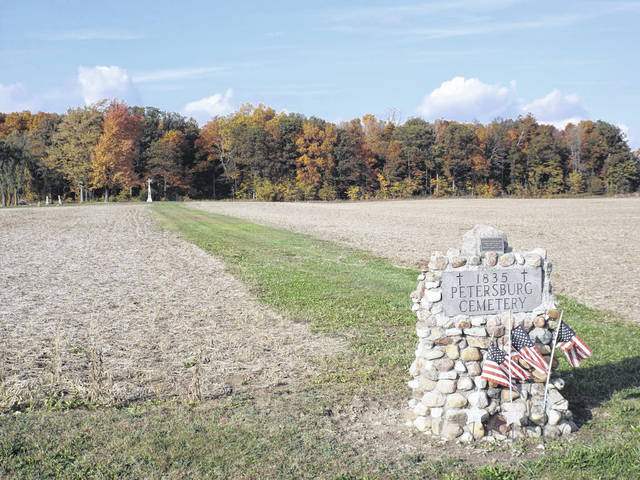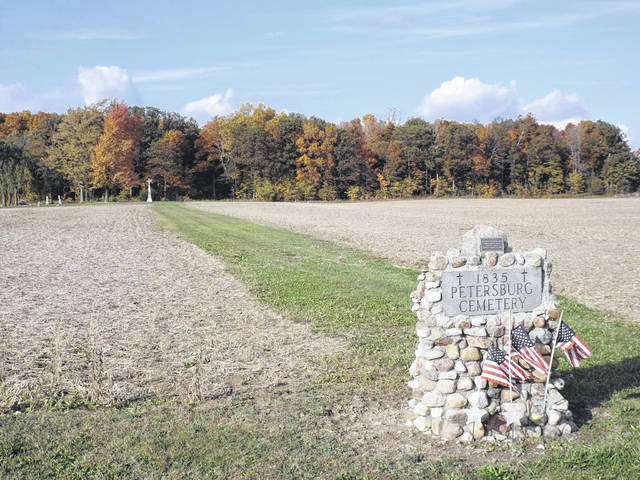

FRYBURG — The Petersburg Parishes will host a dedication for Auglaize County’s eighth and newest Ohio Historical Marker on Tuesday, May 8, 11 a.m. at Petersburg, on Santa Fe-New Knoxville Road, east of Cemetery Road in Pusheta Township. The event is free and open to the public.
The new marker commemorates Sts. Peter and Paul Church, Petersburg, mother church for the Roman Catholic congregations of St. Joseph, Wapakoneta (1839); St. John the Evangelist, Fryburg (1850); St. Lawrence, Rhine (1856); and Our Lady of the Immaculate Conception, Botkins (1865). Saints Peter and Paul Church and its offspring congregations were founded by German-Catholic immigrants to the United States and west-central Ohio.
After the forced removal of the Shawnee from the lands at Wapakoneta (1832), “land buyers in considerable numbers appeared in the [area], and to accommodate them, the land office, located at Piqua, was moved to Wapakoneta. As soon as it opened on the 26th of December, over 1600 hundred acres of land were entered in and around Wapakoneta.” At the time, Wapakoneta, Duchouquet Township (in which Wapakoneta was located), and Pusheta Township, directly south, were located in Allen County, Ohio, but became part of Auglaize County when it was established in 1848.
In 1833 an immigrant from Oberwerrn, Bavaria, named John Ruppert (1795-1880) purchased half of Section 22 in Pusheta Township. The settlement there was called Petersburg. It was to this site that Father Wilhelm Horstman, of the Missionaries of the Precious Blood (CPPS), first traveled on May 8, 1835, celebrating Mass with the German Catholic immigrants.
On April 21, 1836, for the sum of $90, John Ruppert and his wife Anna Mary Ruppert deeded the South Part of the West Part of the SW ¼ of Section 22 to John Joseph Klueppel, et al, “and their successors in office as trustees for the Roman [Catholic] Church in Pusheta Township.”
In 1836, a log church 40 feet by 30 feet (as well as a log residence for the pastor) was built at Petersburg and blessed by Father Horstman.
“Father Horstman, when visiting Minister, would usually stop several days [in Wapakoneta and Petersburg], and provide for the spiritual wants of the Catholics of the community.” The History of the Archdiocese of Cincinnati explains that this was common practice, a church having been informally established before official recognition by the diocese.
“It was on January 1, 1840, as the records of that church tell us, that the parish counting seventy-two families was organized by Father Horstman. The church, blessed under the invocation of the Apostles Peter and Paul, was to serve as the central point for the German Catholics at (what would become) Freyburg, Botkins, and Rhine. But distance and mud roads, which became practically impassable the winter and rainy seasons, caused the Catholics of each of these places to build their own churches.” Parish records indicate that the 72 families of Sts. Peter & Paul Church in 1840 amounted to 318 members.
On Feb. 4, 1841, the trustees of Sts. Peter and Paul Church sold the property to John Purcell, bishop of the Diocese of Cincinnati, for the sum of $90. (As an aside, “[f]orty acres of land, still the property of the congregation, was laid out as a town site in 1852, but the lots never sold.” )
This parish was served by the same missionary priests who attended Petersburg and apparently the same sacramental registers used for Petersburg were used to record events at Wapakoneta St. joseph, which had already been founded in 1839. During the formal establishment of the parish on Jan. 1, 1840, a document was signed by the heads of 72 families of the Petersburg congregation agreeing to share a priest with Wapakoneta and compensate him accordingly.
In 1844 Father Martin Bobst became the first pastor to establish residence at Petersburg. From here he also continued to minister to the parish in Wapakoneta, a practice that continued until 1849, when St. Joseph acquired its own priest and became independent of Sts. Peter and Paul.
St. John the Evangelist parish, was established at Fryburg in 1850, drawing more parishioners away from Petersburg. Soon thereafter, the pastor at Petersburg moved his residence to Fryburg and began serving Sts. Peter and Paul as a mission.
In 1856 Catholics to the southeast of Petersburg established St. Lawrence Church at Rhine. Further injuring Sts. Peter and Paul was the 1865 establishment of Immaculate Conception in the fledgling village of Botkins, south and west of Petersburg along the newly-created Dayton & Michigan Railroad.
The members of Sts. Peter and Paul fought long and hard to keep their parish alive. The 1880 Atlas of Auglaize County states: “This congregation was weakened considerably in 1868 by many members uniting with the Botkins congregation. This almost caused the abandonment of the Petersburg church, but the following year [a number of parishioners] resolved to build a brick church on the Sidney pike, near the county line. Accordingly, a building was erected 55 by 35 feet, for about $3000, but no priest has charge, and so some of the members attend services at Freyburg and others in Botkins.”
The original log church at Petersburg was destroyed in a fire in 1884. A monument to the church was erected on the site of the altar in 1892. The Petersburg congregation had completely disbanded before 1897, as the second church was dismantled at this time and the responsibility of maintaining the cemetery was turned over to St. Lawrence (and later to St. John).
In 1989, St. Lawrence Parish, Rhine, and Immaculate Conception Parish, Botkins, were joined under the administration of one pastor. In July 2009, the Rev. Patrick Sloneker, pastor of St. Lawrence and Immaculate Conception, also became the pastor of St. Joseph, Wapakoneta. Sloneker coined the term “Petersburg Parishes” for the new pastoral region.
In July 2014, St. John the Evangelist, Fryburg, became the fourth parish of the Petersburg Pastoral Region, and the Petersburg Parishes were again one.
The Petersburg Parishes are now served by Sloneker and the Rev. Sean Wilson, associate pastor. The Petersburg Pastoral Region includes Botkins Immaculate Conception, Fryburg St. John, Rhine St. Lawrence, and Wapakoneta St. Joseph churches, and is so named for the now-vanished Petersburg settlement (between Wapakoneta and Botkins) from which the parishes emerged in the 19th century.


